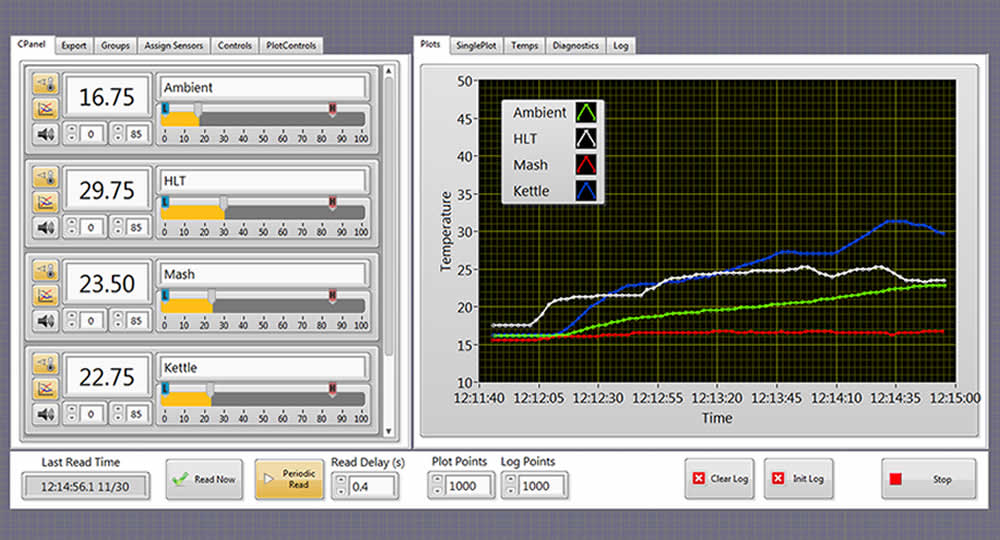LabVIEW_LJM - LabVIEW drivers/examples for LJM support@labjack.com. The executable versions (.exe) are part of the main LabJack software installer for.
I need to use LabJack U12 with labview but i am confused. I have two basic setups to achieve. The first will be a signal generator connected to the LabJack which in turn is connected to the PC. I want to be able to produce a waveform on the PC just as if an Oscilloscope is used. Secondly i will have a power supply, connected to a cell(a fabricated device) which in turn is connected to the LabJack.
My aim is to produce a graph of voltage vs. Time on the PC.

Labview Drivers Download
For both setups i will like to be able to produce graphical displays on the PC instead of on an Oscilloscope. How do i achieve this with LabView while using the LabJack U12. I am using Lab View 6.0 Thank you. Hex- Look one post above yours If you click on that link about getting started with LabVIEW and LabJACK, you can bump up one thread section and just get to the basic LabVIEW section of their forums. It seems like there is a lot of information here and there are apparently examples (I got this from that getting started link) that LabJACK ships with that show example code of dealing with LabVIEW. I don't have any experience with dealing with LabJACK but I think that this is going to be your best point of contact (Although LabJACKSupport, I would think knows a little bit about it ) Grant. I'm trying to use a Labjack U13 on a Mac and with Labview 8.5 Professional Development System.
On this platform there are no drivers so I have been writing my own using the VISA functions. I have managed to get command/response to work fine but I need to use the Stream mode for better timing accuracy. I can configure the stream, start it and stop it without any difficulty but I can not read any data while the stream is running. Regardless of the timeout period (anything from 100ms to 10s) the VISA Read function keeps returning Timeout errors with a Return count of 0.
Does anyone have any suggestions on what's wrong or where I should start looking next? Thanks in advance. I believe you are talking about the LabJack U3, correct? As an alternative, from our forum it looks some people have dabbled with using CIN (code interface nodes) to connect a U3 with our Linux driver (which is very similar to our Mac driver): I am not familiar with using VISA to do USB. Does that mean you are not using our Mac drivers at all, but rather VISA handles opening the device and lets you connect to the different pipes to pass raw data in and out? Did you notice (from Section 2.1 of the U3 User's Guide) that stream data comes in on Endpoint 3, unlike all other data to the host that comes in on Endpoint 2? Note that the last paragraph of Section 2.1 has typos.
It should say: 'All commands should always be sent on Endpoint 1, and the responses to commands will always be on Endpoint 2. Endpoint 3 is only used to send stream data from the U3 to the host.'
SolutionIf you installed the driver through an executable, you must locate the drivers that were installed and move them to the correct folder. On a Windows computer, this location of the driver is frequently IVI Foundation VISA mydriver where mydriver is the name of the driver you installed. For Mac OS, the location is frequently IVI Foundation VISA mydriver. The mydriver folder will be the folder you need to copy to a new location.

If the driver you downloaded did not have an executable, make sure you have unzipped the folder, and then that folder will be the one that you need to move. Now that you have located the driver folder, do the following to add the driver to LabVIEW:. Exit out of LabVIEW if it is currently loaded in memory. Copy the driver folder to the following location for a Windows computer:. National Instruments LabVIEW (year of LabVIEW you are using) instr.lib.
The location could also be under depending on if you are using a 32 or 64 bit version of Windows or LabVIEW. For a Mac computer, copy the driver folder to the following location. National Instruments LabVIEW instr.lib. Rename the driver folder to the driver name you would like to appear in LabVIEW. Re-open LabVIEW.
Open a new VI and right-click on the block diagram to open the Functions Palette. Your instrument drivers should appear under Functions » All Functions » Instrument I/O »Instrument Drivers on the Functions Palette as shown below. Additional InformationFor LabVIEW to access an instrument driver through the Functions Palette the driver must be located in the instr.lib directory, which is contained in your LabVIEW folder, LabVIEW instr.lib. The instr.lib folder has the instrument driver folders containing all necessary.mnu files and a.llb or.lvlib file as well. The.mnu files alone only tell LabVIEW where on the palette the VIs should be found and do not contain the source.
The source for the driver files can be found in the.llb or.lvlib file. Some third party drivers will install these files to the IVI Foundation VISA directory, where LabVIEW will not be able to find them. In this case, you must manually copy and paste these files to a folder within the instr.lib directory. For example, consider a driver named mytest which installs to IVI Foundation VISA mytest and contains subfolders Examples and LabVIEW.